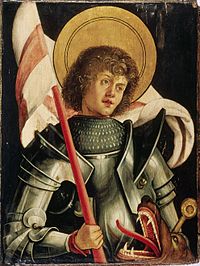St. George
| Saint George of Lydda | |
|---|---|

Portrait by Hans von Kulmbach (circa 1510).
|
|
| Martyr | |
| Born | AD 280 Lydda, Syria Palaestina, Roman Empire |
| Died | 23 April 303 Nicomedia, Bithynia, Roman Empire |
| Venerated in | |
| Major shrine | Church of Saint George, Lod, Israel |
| Feast |
Saint George's Day: 23 April (Gregorian 6 May when Julian date is observed) |
| Attributes | Clothed as a crusader in plate armour or mail, often bearing a lance tipped by a cross, riding a white horse, often slaying a dragon. In the Greek East and Latin West he is shown with St George's Cross emblazoned on his armour, or shield or banner. |
| Patronage | Many Patronages of Saint George exist around the world |
Saint George (Greek: Γεώργιος Geṓrgios; Latin: Georgius; AD 275–281 to 23 April 303), according to legend, was a Roman soldier of Greek origin and officer in the Guard of Roman emperor Diocletian, who ordered his death for failing to recant his Christian faith. As a Christian martyr, he later became one of the most venerated saints in Christianity.
In hagiography, as one of the Fourteen Holy Helpers and one of the most prominent military saints, he is immortalised in the myth of Saint George and the Dragon. His memorial, Saint George's Day, is traditionally celebrated on April 23. (See under "Feast days" below for the use of the Julian calendar by the Eastern Orthodox Church.) Numerous countries, cities, professions and organisations claim Saint George as their patron.
George's parents were Christians of Greek background; his father Gerontius (Greek: Γερόντιος Gerontios) was a Roman army official from Cappadocia, and his mother Polychronia was a Christian and a Greek native from Lydda in the Roman province of Syria Palaestina (Palestine). Accounts differ regarding whether George was born in Cappadocia or Syria Palaestina, but agree that he was raised at least partly in Lydda.
...
Wikipedia
